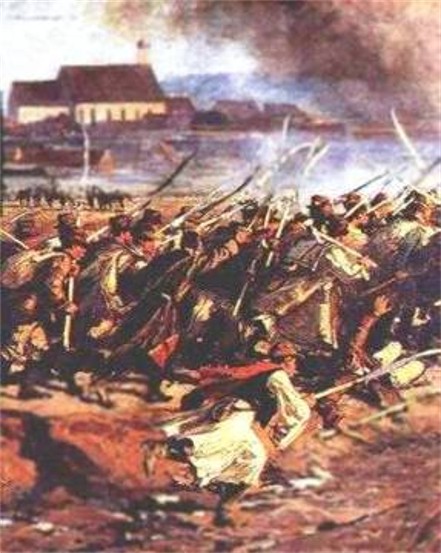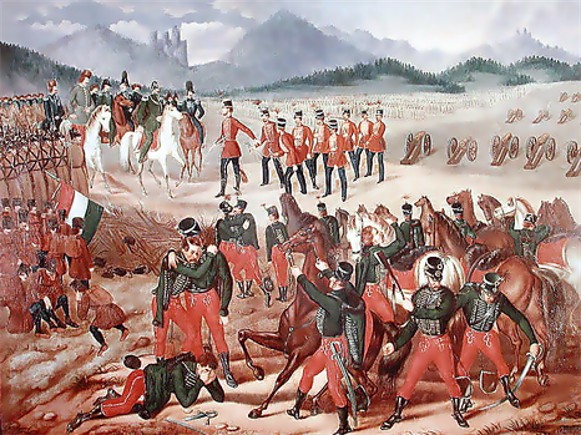Revolution of 1848–9 in the Habsburg monarchy
Revolution of 1848–9 in the Habsburg monarchy. The unsuccessful democratic revolution that encompassed much of Europe in 1848–9, which broke out also in the Habsburg monarchy, including the Ukrainian territories. Inspired by a republican revolution in Paris in February 1848, demonstrations broke out in Vienna in March. By mid-month, under pressure from the people, Emperor Ferdinand I had dismissed his reactionary adviser Klemens von Metternich, authorized the formation of a national guard, and promised to establish a parliament. The news of those revolutionary events reached the Ukrainian territories of Galicia, Bukovyna, and Transcarpathia on the weekend of 18–19 March. Immediately crowds gathered in the squares of Lviv, where Polish democrats circulated a petition calling for civil rights and the abolition of serfdom. In Chernivtsi mobs attacked the unpopular mayor and police commissioner. In the small, largely Magyarized towns of Transcarpathia the population gathered to read and discuss the 12 demands put forward by radical Hungarian activists in Pest. Thus began a period of revolutionary development that did not come to an end until the Hungarian revolutionary army surrendered to Austrian imperial and Russian forces on 13 August 1849.
Prior to the revolution there had been a Ukrainian national revival in Galicia and Transcarpathia, but the movement had been entirely cultural. With the outbreak of the revolution, however, the Ukrainian question became a political question. The first representative Ukrainian political organization was founded in Lviv on 2 May 1848, the Supreme Ruthenian Council (HRR). It was established as a counterweight to the Galician Poles' National Council (Rada Narodowa) and saw as its chief purpose the defense of the Ukrainian nationality against Polish domination. The Poles attempted to thwart the HRR by establishing the rival, pro-Polish Ruthenian Congress in late May, but that organization had little influence in Ukrainian society.
The major political goal advocated by Ukrainians during the revolution was the creation of a predominantly Ukrainian crown land within the Habsburg monarchy. The Galicians, in particular the Supreme Ruthenian Council, took the lead. The HRR gathered 200,000 signatures on a petition calling for the division of Galicia into separate Ukrainian and Polish provinces (Eastern Galicia was largely Ukrainian, western Galicia largely Polish). Some Transcarpathian Ukrainians, notably Adolf Dobriansky and Oleksander Dukhnovych, sought to have Transcarpathia joined to Ukrainian Galicia, and petitioned the emperor to that effect in January 1849. In 1848 Bukovyna was still part of Galicia. Romanian politicians hoped, however, to detach it and eventually unite it with other Romanian-inhabited territories. The status of Bukovyna was debated in the Austrian Reichstag. The Ukrainian deputies from Bukovyna as well as the HRR sought to keep Bukovyna, or at least Ukrainian-inhabited northern Bukovyna, attached to Ukrainian Galicia. Although the relatively underdeveloped Ukrainian movements in Transcarpathia and Bukovyna were as yet unclear on the point, the Ukrainians of Galicia repeatedly emphasized in their publications that the Ukrainians of the Habsburg monarchy were part of the same distinct Ukrainian nation that could be found in Ukraine in the Russian Empire.
In June 1848, Ukrainians participated in the Slavic Congress in Prague (see Slavic Congress in Prague, 1848). Three delegates from the Supreme Ruthenian Council sought to defend Ukrainian interests against Polish pretensions, and also to work out a basis for co-operation with the Poles. No Transcarpathian Ukrainians attended the congress, but the Slovak delegation called for the protection of their national rights in the face of Hungarian chauvinism.
Also in June 1848 the Ukrainians of Galicia and Bukovyna participated in the first parliamentary elections ever held on Ukrainian territory, the elections to the constituent Austrian Reichstag. Altogether 30 Ukrainians were elected (of 383 deputies in total). The Ukrainians of Galicia organized a Ukrainian People's Guard (fall of 1848) as well as the volunteer Ruthenian Battalion of Mountain Riflemen (winter of 1849) to combat Hungarian insurgents. Throughout the revolution the vast majority of Ukrainians remained loyal to the emperor.
The revolution accelerated Ukrainian cultural development. The first Ukrainian-language newspaper, Zoria halytska, began to appear in Lviv on 15 May 1848, and several more Ukrainian periodicals were founded within a year. In October 1848 Lviv hosted a Congress of Ruthenian Scholars attended by over a hundred delegates. The congress formally established the Halytsko-Ruska Matytsia, a Ukrainian literary and educational society that had existed informally for several months.
The Ukrainian movement made rapid progress during the revolution because the revolution emancipated and politicized the peasantry, who constituted the vast majority of the Ukrainian nation. As early as 22 April 1848, earlier than anywhere else in Austria, the governor of Galicia, Franz Stadion, abolished serfdom. Even though Bukovyna was still administratively part of Galicia, the early abolition of serfdom did not apply to it. That unfavorable separate treatment provoked unrest among the Bukovynian peasantry which continued even after serfdom was abolished there on 9 August 1848 (retroactive to 1 July). The abolition of serfdom still left many questions of vital interest to the peasantry unresolved (notably, the question of compensation to landlords for the abolition of compulsory labor and other feudal rents and the status of the traditional rights of peasant communities to forests and pastures); the peasantry therefore took an active interest in politics during the revolution. In the elections to the Austrian Reichstag in June 1848, Ukrainian peasants tended to elect fellow peasants to represent their interests. Sixteen of the 25 Ukrainian deputies from Galicia were peasants, as were all 5 from Bukovyna. One of the Bukovynian deputies was Lukian Kobylytsia, who had led a peasant uprising in the mid-1840s. After the Reichstag was temporarily dispersed in October 1848, Kobylytsia returned to his village and organized an armed rebellion. In Transcarpathia serfdom was largely abolished by the Hungarian revolutionary government on 18 March 1848. In 1848–9 Ukrainian peasants refused to perform labor on seignorial estates and seized much property disputed between landlords and peasants. In the summer of 1849 the Western Ukrainian countryside was placed under military occupation so that order would be restored.
The end of the revolutionary period, May–September 1849, saw the appearance of Russian troops in Western Ukraine, brought in to subdue the Hungarian insurgent army. The Russians passed through Bukovyna on their way in and through Bukovyna and Galicia on their way out. They stayed longest in Transcarpathia, where Adolf Dobriansky was assigned to them as a liaison. The presence of the Russian military in Transcarpathia in 1849 is considered an important moment in the genesis of Russophilism in the region.
The revolution had been defeated by the fall of 1849, and many of the achievements of the revolutionary years were undone. The Austrian government dissolved the Reichstag in March 1849, the Supreme Ruthenian Council was dissolved in 1851, and the Ukrainian periodical press declined through the 1850s until it almost disappeared. The peasants remained emancipated, but on terms much less favorable than they had hoped for. The rebirth of constitutional government in the 1860s restored some of the gains of 1848 in Galicia and Bukovyna, including a Ukrainian periodical press and Ukrainian representation in a parliament.
BIBLIOGRAPHY
Vozniak, M. Iak probudylosia ukraïns’ke narodnie zhyttia v Halychyni za Avstriï (Lviv 1924)
Danylak, M. Halyts’ki, bukovyns’ki, zakarpats’ki ukraïntsi v revoliutsiï 1848–1849 rokiv (Bratislava 1972)
Wagner, R. Die Revolutionsjahre 1848/49 im Königreich Galizien-Lodomerien (einschliesslich Bukowina): Dokumente aus österreichischer Zeit (Munich 1983)
Kozik, J. The Ukrainian National Movement in Galicia: 1815–1849 (Edmonton 1986)
John-Paul Himka
[This article originally appeared in the Encyclopedia of Ukraine, vol. 4 (1993).]

